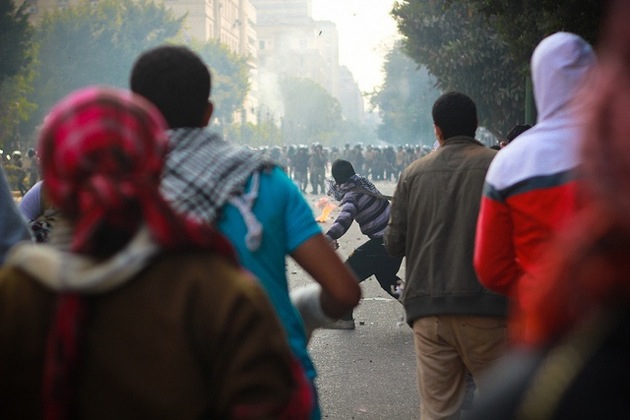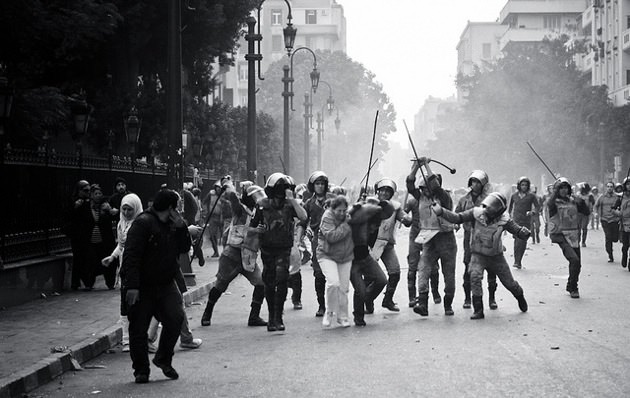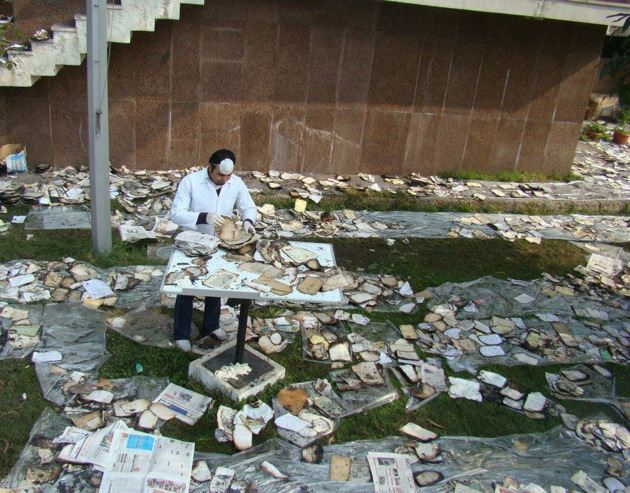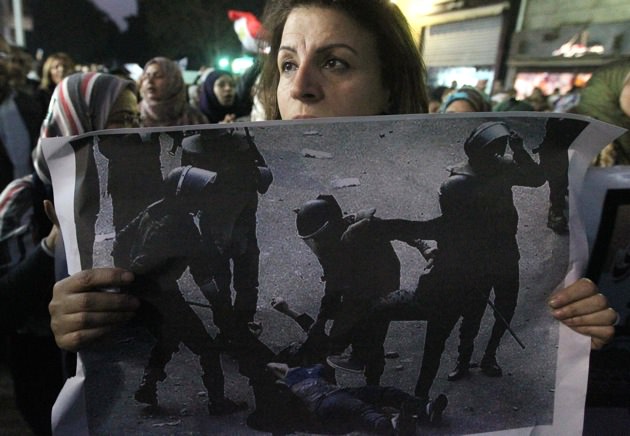To live in Cairo these days is to live in constant disorientation. You wake up on Friday to violent clashes between the army and civilians, on Saturday to young people rescuing old books from a government building engulfed in flames, on Sunday to images of women being assaulted by uniformed soldiers, on Monday to pools of blood in the city’s central square, and on Tuesday to thousands of women marching through the streets of downtown chanting for freedom, cheered on by a human shield of men. A week later, nearly all the traces of these events are gone: except for some graffiti, the odd tent in Tahrir, and a few barricades of barbed wire and concrete blocks, the city feels listlessly unchanged, almost as if the revolution never happened.
The past two weeks in Cairo brought all of this and more, as has much of the fall. Amid moments of hope for stability and lasting change—such as Egypt’s first free and fair parliamentary elections, which began on November 28 and end next week—the country has faced wave after wave of unpredictable violence between civilians and security forces. Peaceful protesters are arbitrarily being arrested and thrown in jail; and the army’s estrangement from the activists who led the revolution is visible in the newly-erected concrete walls that sever downtown streets to separate its forces from the people. Last week, security forces raided 17 offices of internationally-funded NGOs, confiscating computers, documents, cameras, and bizarrely, even office tea kettles. It was the latest attempt to tarnish the image of the activists, and more urgently, abort the possibility of another ‘January 25’—this time against the Supreme Council of Armed Forces (SCAF), which has been in power since Mubarak stepped down.
From their position as the apparent protectors of last year’s revolution, SCAF have been pushed into increasingly brutal confrontations with civilians—at Maspero in October, during the run-up to elections in November, and most recently, during a week of mayhem in mid December. These spasms of violence, as important to the future of Egypt as the outcome of elections, often seem to have a logic of their own; December’s episode was set off by a chain of events few could have predicted.
On Friday, December 16, a three-week-old standoff outside the cabinet offices between the army and a hundred-odd protesters calling for the resignation of the current prime minister—Kamel El Ganzouri, a former Mubarak cabinet member—suddenly escalated from an exchange of rocks into a fully-fledged battle. By 10:30AM, the military—with the apparent help of plainclothes agents —had bludgeoned the protesters and chased them away. In the confrontation, two protesters were shot dead and dozens injured; twenty were also detained and beaten in custody. By noon, the protesters had regrouped at an intersection of a main downtown thoroughfare, Kasr El Aini, and I watched as soldiers and plainclothes agents threw rocks, glass, and Molotov cocktails down at them from atop a nine-story government building. All around me, people were protecting their heads with plastic construction helmets (now sold for $1.50 from street vendors around Tahrir Square) or Tefal cooking pots; young boys meanwhile rushed in with broken slabs of pavement, old newspapers, and empty water and Fanta bottles. “Ammunition,” one of them explained. (The bottles are filled with gasoline, stuffed with rolls of newspaper, and ignited, making Molotov cocktails.)
The clashes continued into late afternoon, and as I walked through Tahrir on my way home just after sunset, I received a text that Sheikh Emad Effat, a senior Islamic cleric at Al-Azhar University (and the husband of an old friend), had been killed in front of the cabinet building–one of the morning’s two victims—apparently shot at close range, most likely by plainclothes agents or thugs. “He was definitely targeted,” a close associate of Ali Gomaa, the Mufti of Al-Azhar, told me later. “Although the bullets weren’t fired by a soldier, the army is clearly complicit, letting it happen.” The theory was the government was trying to use the death of a popular Sheikh to stir anger towards the protest movement, but at a funeral march the next day that started at Al-Azhar and ended at the cemetery, thousands of mourners instead called for the end of SCAF rule.
Friday’s fighting continued late into the night, and early Saturday dozens of soldiers charged through Tahrir with shields and batons to clear the few hundred people who had remained in the area or returned that morning. It was then that the notorious beating of two women was captured on video In the 90-second segment, a woman in jeans and a black abaya and headscarf is pounded with batons, kicked, stomped on with heavy army boots, and then dragged by a group of soldiers across the littered tarmac in Tahrir. A woman in a red coat comes rushing to her rescue, only to be beaten too—by a dozen soldiers with boots and sticks. The two women—now known as #bluebragirl and #redcoatwoman—were both hospitalized with serious injuries (#redcoatwoman is reportedly suffering from amnesia).
Advertisement
Even amid the routine violence of the past year, these attacks were shocking; with few exceptions, women have felt relatively safe in the revolution’s protest movement. The last time women were targeted by security forces in this way was in 2005, during an anti-Mubarak demonstration, and then, there was little visual documentation of what happened. This time, within minutes of the incidents, the videos went viral on Facebook and Twitter; uniformed soldiers were very clearly assaulting women, both old and young—some seasoned activists, others simply students, teachers, doctors, or shopkeepers who had been taking part in the protests. A few of the victims seem to have been innocent bystanders, who had simply been passing through the area when they came under attack. (The army, for its part, denied using force against protesters despite the indisputable video evidence.)
By midday Saturday, the escalating clashes had meanwhile brought post-Mubarak Egypt to an altogether different kind of low point, with the destruction of a rare book library housed at the historic Egyptian Scientific Institute. That morning, hundreds of soldiers and protesters had formed facing lines just behind an intersection flanked by the institute and a building of the American University in Cairo. There, the army and their plainclothes agents hurled rocks and sheets of glass at protesters, who threw them back—occasionally adding a Molotov to the mix. Around 1PM, the institute, which was founded by Napoleon in 1798 (as the Institut d’Egypte), and contains some 200,000 rare books, caught fire.
Some believe the army started the fire in an effort to cast protesters as anarchists (Mubarak’s regime had similarly torched his own party headquarters during the January protests); others suggest a Molotov cocktail hurled by the protesters entered one of the windows on the second floor, causing the blaze. A friend who is an architectural historian and conservator examined the building later and told me it was clearly ignited from the inside. Whatever the explanation,, the army did little to quell the flames, and when protesters rushed to a fire station down the street urging the fire fighters to rush fire engines to the scene, they refused, saying they had received “no official orders.”
It wasn’t until early evening that people in the street managed to put out the fire (by bringing in buckets of sand and water, and connecting hoses to nearby water mains). I had left in the late afternoon, and around 8.30PM my brother Seif called suggesting we return to downtown. “Ahmed and others have gotten into the institute, they’re saving books,” he told me, referring to a friend. When we got there, about 2000 people were watching the still unfolding battle between the army and protesters. Rocks were flying everywhere, crackling sounds filled the air, and the sirens of ambulances echoes nearby and in the distance. Young men flashed red and green laser beams up at building tops to indicate where soldiers or agents stood. We moved forward, trying to reach Ahmed, who had crossed an army barricade to where some books had been moved (the army was cooperating in the rescue effort). As we slowly advanced, we bumped into the historian Mahmoud Sabit—his father was a cousin of Egypt’s Queen Nazli—who told us he had visited the library in the 1970s and seen, among other things, an original Gutenberg Bible.
When we reached the barricade, a protester pushed us away, screaming that no women should be there. “Get bags, gets bags,” someone called at us from behind him. We eventually pushed our way back with garbage bags we had acquired nearby, and piles of rescued books were placed in them. Soldiers warned us to leave and, around midnight, we retreated to Tahrir, where thousands of people were loitering, many of them screaming in outrage at the front page of the next morning’s independent El-Tahrir newspaper, which was circulating the square (the first edition had just reached newsstands). A picture of #bluebragirl being dragged through Tahrir by the three soldiers filled the top third of the paper. Many said that the army had to be held accountable, but some disagreed. “She was asking for it,” one man said.
It was approaching 2AM when we left, and not long after, I started getting Twitter messages that clashes had intensified again. Accounts were inconsistent, but just before dawn a friend who lives in a penthouse overlooking Tahrir tweeted “nonstop gunshots now”; “security forces running after protesters in downtown streets.” Videos he took show dozens of soldiers storming the square. Nine people had been killed by that point and over 300 injured.
Advertisement
By 7.30AM Sunday, the army had left the square but clashes were again taking place at the intersection by the ESI building. When I got there, I found a dozen volunteers putting any books and papers they could find into empty construction sacks that a government truck had brought in early that morning. The roof of the charred institute had by now fallen in, and a front façade was concave and swaying; someone nearby warned that the building might collapse. Seif and his friends shuttled books out to nearby collection points (one at a church, another behind an army barricade) where government trucks were arriving to transport them to Dar Al-Wathaiq Al-Qawmiya—the National Archive. Meanwhile, the fighting continued; my brother was hit in the back with a rock, and many others barely missed being hit by rocks or flying glass.
That morning, the Central Security Forces had replaced army soldiers. The military has shown an ominous willingness in recent months to turn over crowd control to the notoriously violent riot police, but in this instance, it seemed to be attempting to curb an escalation of anti-SCAF dissent following the blatant abuses by soldiers the day before. At 8PM, after many false alarms that the Central Security Forces were planning a major assault to clear the area, I left for the National Archive. There, truckloads of damp and burnt books had been unloaded into the garden, and in what space there was on the ground floor (for damaged books) and an empty fourth floor room (for intact books). Some were charred beyond recognition, others torn and singed beyond repair. About a dozen volunteers aided a small team of professional conservators. “Damp on this side, dry on this side,” one of the conservators, John Mumford, told us as we walked in. “Fragments here. We have to keep everything, it’s not up to us to decide if things are to be thrown away.”
As we sifted through the piles and sacks and garbage bags, we came across locally produced scientific journals, handwritten documents and diaries in English and French, a Japanese book from the early 1900s; a French one from 1863; a daily Egyptian newspaper (in English) from the 1870s; an illustrated copy of the Merchant of Venice; a Cincinnati Museum exhibition catalogue from a 1908 exhibition of French Impressionists; a map of Egypt and the surrounding region from the 1700s; a scientist’s diary from 1911. At 10.40PM, Seif turned up the most significant find: parts of the Description de l’Egypte, Napoleon’s project to document the entire civilization of Egypt in several editions of up to 38 volumes, consisting of descriptive texts, maps, and almost 900 plates of over 3000 drawings. Conservators and volunteers rushed to our room. “The good news,” our friend Ola, a rare books and manuscripts expert, told us, “is that this looks like the third edition.” Since then, Egypt’s recently appointed Minister of Culture has said that the much-prized first edition is kept in a national vault. A few days later, the front page of the collection was found.
Amid the turmoil, political leaders and factions were swift to condemn the army’s violence, calling for an immediate handover of powers from the SCAF to an interim presidential council or leader. A few newly appointed parliamentarians (including the liberal Amr Hamzawy, who won in the district of Heliopolis) came down to Tahrir to try to broker a truce. The Islamists, for their part, were largely silent, cautious about taking sides despite the army’s flagrant offences. Still, there was broad agreement that during this latest bout of violence the military was increasingly out of control (in one incident, video footage shows uniformed soldiers urinating on protesters from atop government buildings). Others suggested that the unruly behaviour and the evident involvement of third parties (thugs and armed plainclothes agents) reflected rifts within the army and its leadership.
By Tuesday morning the protesters were mostly gone, and downtown was calm, though filled with new barricades. People seemed despondent from the weekend’s events, and few expected a large turnout at the women’s march planned for that afternoon to protest army brutality. Yet the gathering quickly grew from a handful of women to some 800. Many of them held up banners denouncing the SCAF, some with collages of the newspaper pages depicting the brutality of the past few days. I joined the group with a friend, and my brother joined the men who were beginning to form a human shield around us to protect against possible attacks by thugs.
The crowd started moving around 4PM, beginning with a march around Tahrir Square. As we marched, we chanted for freedom, and for people to demand that the SCAF relinquish power. The men who surrounded our march chanted back, “The women of Egypt are a red line.” As the march moved from Tahrir into the streets of downtown, many simply stared. Others cheered us on. “Ya Ahaleena, Indamu Leena” we chanted, in a rhyming call to “come down and join us.” More and more did, and by 6PM, Al-Jazeera was announcing that there were 8,000 women, plus a few thousand men surrounding them and forming their own march behind us. There were many students in the crowd, as well as people I recognized like the artist Hala ElKoussy, the film producer Mona Asaad, the playwright Laila Soliman, and Samia Jahin, a member of the popular local music group Eskenderella. Some women said they supported the Islamists, although none I talked to were formally members of a political party or group.
As with the remarkable calm of the first day of parliamentary elections in late November, the march felt like a turning point—a shift from the absolute despair of the preceding days to a sense of hope that Egyptians might find a cause that could transcend the bitter political and social divisions that have surfaced since the revolution. Indeed, only a few hours into the march, the SCAF issued a statement expressing “regret” at the brutality against women. But it was yet another fleeting moment of unity.
By Friday, December 23, calls for a million-man “Friday of Honor” protest against the military and in memory of those killed in recent weeks largely fizzled. The Islamists announced that they wouldn’t be taking part “in the interest of the stability of Egypt (the Prime Minister had earlier called for a “two month period of calm”), and as the most widely-supported faction, their absence meant that only about 10,000 people turned up. The Muslim Brotherhood has maintained close dialogue and relations with the SCAF since February 11, and seems fearful of antagonizing the military as its own influence grows. In the second round of elections, it swept another 36 percent of the parliament (the Salafis took 28 percent), and is predicted to show similar strength in the just-completed third round. The Islamists now have almost 70 percent of the contested parliamentary seats, and are expected to gain even more when the third round and run-off results are tabulated next week.
Many who stayed home from the protest reiterated the widely-held belief, that, as one man told me, “These protesters are nothing but trouble, they are ruining the country and destroying the economy.” Despite the army’s growing use of repressive measures and its close association with the former regime, many Egyptians say there is no alternative way to maintain stability. Many also argue that the protesters revel in chaos; and indeed, at recent clashes, I’ve often noticed young boys—many of them street children and teenagers—stirring up confrontations.
In spite of this, the military council is showing signs of being unnerved by its own waning support, and has been quick to offer a new round of concessions: the release of activists who had been detained pending investigation, a court ruling against an army chief for subjecting female protesters to “virginity tests” last year, a new election timetable that means the entire parliament (upper and lower houses) will be in place by February rather than March, and a handover schedule that slates presidential elections for April instead of June.
While these concessions are a step in the right direction, all it may take to prolong the transition to an elected civilian leadership with true authority is another outbreak of violence. And even if a handover of presidential powers happens as promised, it seems unlikely that the protest movement and the periodic clashes will subside anytime soon. Poverty levels are stuck at over 40 percent, inflation and prices are high, wages are low, health care is bad, and the education system is abysmal. Even traffic has become a concern – the city is constantly gridlocked, taxing everyone’s nerves. In many ways, addressing such mundane issues may prove to be the most pressing challenge for both the current and future leaders. And even if the plummeting economy does—by some miracle—improve, few are likely to forget the army brutality of the past few months.
On the evening of Sunday, December 25, as I walked in my neighborhood and wondered about the Santa standing at a hotel entrance – if he would be there in a year or two if the Islamist stronghold in parliament remained—I followed a Twitter feed about the 31-year-old dentist and activist #AhmedHarara. On January 28 last year—the fourth day of the revolution—his right eye was taken out by a rubber bullet fired by government forces, then under the Mubarak regime. He then lost his left eye on November 19—it too taken out by a bullet fired by government forces, now under military rule. Harara had gone to France for an eye transplant, which failed, and as he landed at Cairo International Airport, hundreds of supporters were there to welcome him home. “A real hero. He gave up his sight for freedom,” someone tweeted.
In such a volatile environment, and with the revolution itself pulled in different directions by different groups, what seems most important is not how many people actually turn up in Tahrir, but rather, the heroes and leaders—until now sorely lacking—those protests might yet create. In the meantime, many of us are left wondering how many more of the roads leading to Tahrir will be barricaded and blocked in the three weeks remaining until the January 25 anniversary of our revolution.






